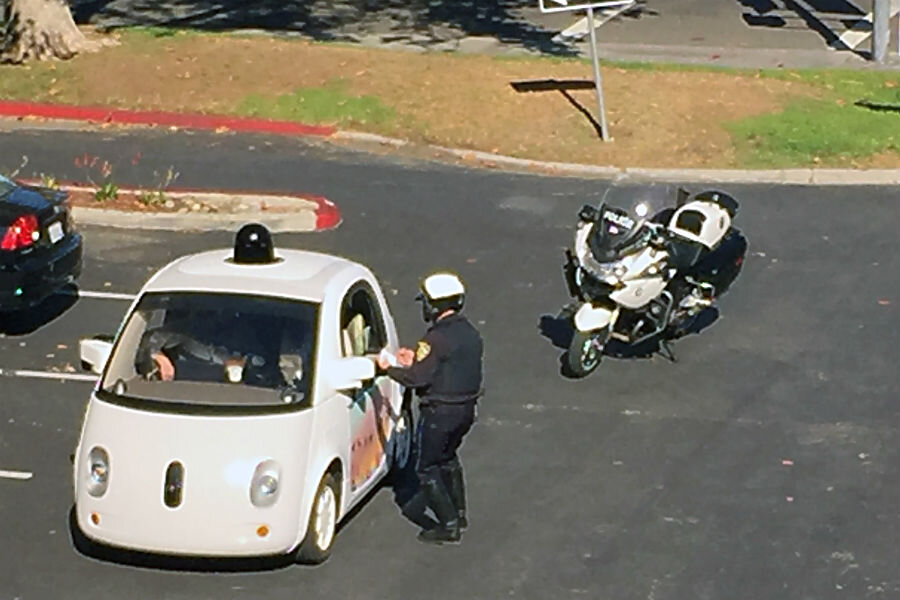What is the future of driverless cars?
Loading...
If the several companies already testing their self-driving automobile technology are to be believed, the future is now. Driverless cars could be integrated into traffic within the decade.
Ford announced Friday that it will begin testing self-driving cars at a new compound called Mcity, a 32-acre fake metropolis in Ann Arbor, Michigan.
Mcity is a collaboration of Ford, the University of Michigan, and the state’s Department of Transportation. The Detroit car company won’t be the only manufacturer to use the compound; it is one of many automakers that have poured $1 million into the testing grounds, which include traffic lights, pedestrian zones, storefronts, and other real-life elements.
“We’ve been testing [autonomous] cars in the real world, but using a place like Mcity will allow us to refine our algorithms and better calibrate car sensors by repeating specific situations in a reliable way,” Ford’s vice president of global product development Raj Nair told USA Today.
Meanwhile 2,400 miles away, the Web giant Google is testing its own line of self-driving cars. Google has been testing autonomous cars for more than seven years, mostly in Mountain View, California but also recently in Austin, Texas.
Google’s driverless cars made the news Thursday when one was pulled over by police. No, it wasn’t speeding – it was going 24 miles per hour in a 35 mph zone. Fortunately for Google, no citation was issued, and the company's driving record remains pristine.
“Driving too slowly? Bet humans don’t get pulled over for that too often,” the company wrote in a Google Plus post. “After 1.2 million miles of autonomous driving (that’s the human equivalent of 90 years of driving experience), we’re proud to say we’ve never been ticketed!”
A number of reports suggest that Apple is also getting into the autonomous car business. The computer company has been hiring car engineers, and there have been rumors of a facility similar to Mcity just outside of San Francisco.
Tesla, Elon Musk’s electric car venture, just unveiled an autopilot feature in its cars’ software that steers and changes lanes without human intervention. This signals a more gradual approach to driverless technology, though it seems that Google’s all-in efforts will reach the finish line sooner.
It seems undeniable that the driverless cars are coming, and soon. Google claims its self-driving cars will be on the market in five years. But what does this mean for the overall transportation grid?
According to Robin Chase, the former CEO of Zipcar, it could be either heaven or its opposite. In the latter scenario, the masses will flock to purchase the autonomous cars, which will be sent out to run errands on their own, and traffic will become irrevocably congested.
“If single-occupancy vehicles are the bane of our congested highways and cities right now, imagine the congestion when we pour in unfettered zero-occupancy vehicles,” she wrote in CityLab.
Additionally, the rollout of driverless cars could have a dire impact on public transportation – particularly buses – and the low-income residents who depend on it, especially in smaller cities where transportation infrastructure is already lacking. Even if driverless cars provide ride services cheaper than taxis and Ubers, it’ll still be much more expensive than a month of rides with an unlimited card.
But if autonomous cars could supplement, and not compete with, existing public transit systems, then the opposite could happen: roads could become less congested because fewer people would have cars (this has already started to happen with the rise of Uber and Lyft), and fares would become just as affordable as buses.
“While the hell vision results in gridlock everywhere, this heaven vision takes all those personal cars – now parked 95 percent of the time – off the streets and out of garages,” Chase continued. “We can repurpose those lanes to trees, bike lanes, sidewalks, play spaces, bike parking, café expansion, community gardens, or even swimming pools.”
But an effective system calls for effective regulation, and the public sector has been struggling to keep up with recent innovations such as Uber. Even if autonomous cars are to adequately replace buses with lowered operational costs, there’s still the question of optimal routing. Also, will city governments be ready to provide subsidies so the service can be affordable to everyone?
Yonah Freemark of The Transport Politic suggests that it is too soon for a complete upheaval of the transportation system in favor of self-driving cars and other technologies.
“New technologies offer the opportunity to change the way we think about transportation and likely offer us opportunities to improve our cities,” he wrote.
“But the public sector, and the civic sector in general, must continue to play the key role in planning, identifying essential investments, and aiding those who are in need.”








